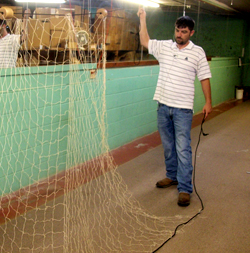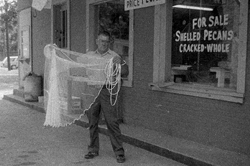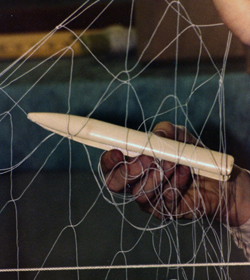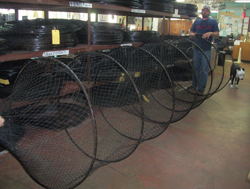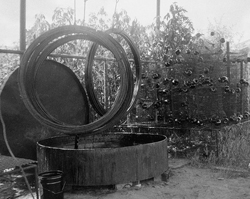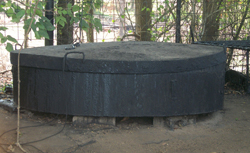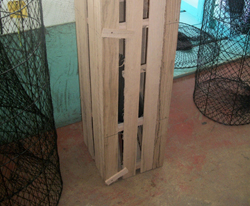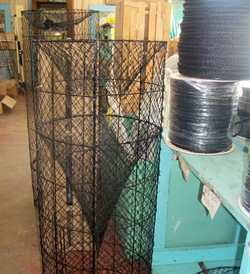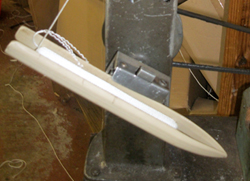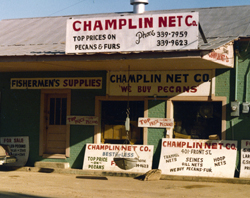Introduction to Delta Pieces: Northeast Louisiana Folklife
Map: Cultural Micro-Regions of the Delta, Northeast Louisiana

The Louisiana Delta: Land of Rivers








Ethnic Groups










Working in the Delta








Homemaking in the Delta



Worshiping in the Delta



Making Music in the Delta




Playing in the Delta







Telling Stories in the Delta



Delta Archival Materials
Bibliography

Nets and Net Making in the Delta
By Sheila Richmond
Often called "The Bayou State," Louisiana has an extensive water system. With the Mississippi River, Gulf of Mexico, Pearl River and Sabine River serving as borders, the state also contains various rivers and bayous, intra-coastal canals, and small creeks and branches. Louisiana has a close connection to all things aquatic.
Even parishes in the interior of the state boast of lakes, rivers, bayous, and creeks. Two parishes in east central Louisiana, LaSalle Parish and Catahoula Parish, have between 5% and 6% of their total size in waterways (LaSalle Parish). Those percentages may seem a bit low, especially when considering specific bodies of water. The Scenic Rivers named in 2011 for these parishes include Trout Creek, Saline Bayou, and Little River (La. Department). Other major bodies of water in these parishes include Lake Louis, Larto Lake, and Catahoula Lake.
Catahoula Lake in LaSalle Parish is a combination of marsh, open water, and complex river system. It sometimes grows to as much as 33,000 acres (Gibson). The lake furnishes ideal conditions for timber, trapping, and commercial fishing. It can also be unpredictable, even for seasoned fishermen. Vernie Gibson from LaSalle Parish fished both commercially and for sport for most of his 80 years. He notes that Catahoula Lake is variable: "Water that was five feet deep one day will be twelve feet the next time you fish it" (Gibson). The lake also tends to dry up quite a bit in the summer, making fishing more difficult. In Jonesville in Catahoula Parish, waterways dictate much of the commerce. It is at Jonesville that the Ouachita River, the Tensas River, and Little River come together to form the Black River. It is certainly no surprise that fishing, both commercial and for pleasure, is such a big business. In addition, these parishes include all or part of the Dewey Wills Wildlife Management Area, Sicily Island Hills Wildlife Management Area, National Catahoula Wildlife Management Preserve, and Boeuf Wildlife Management Area. This landscape of waterways and the fishing culture generate numerous occupational folk traditions, including a network of commercial and private net makers producing a variety of nets.
Life in the Delta
It is no wonder that people from LaSalle and Catahoula Parishes have lifestyles more elementally tied to nature—fishing, trapping, hunting, boat making, net making, wild game cooking, and a basic outdoor life. The folks who live here can do a bit of everything. Living in sometimes isolated places, they have had to learn to make do. They and their families are tied to the vagaries of nature and weather, dictating the seasons—fishing and hunting, in addition to planting and harvesting.
Anthropologist H. F. Gregory's comments about fishing in Concordia Parish apply to LaSalle residents as well:
Commercial fishing has been a way of life in Concordia and Catahoula Parishes since the early 1900s. The fisherfolk who lived "over the levee" or "down the river" or "in the swamp" were, and still are, a unique group of Delta people. They lived, even prospered, on a land where farming and industry failed. They remained through the floods, learning to live with the water rather than to fight it. Sometimes forgotten, often ignored, they contributed more to the regional economy than their neighbors knew (Gregory 19).
Gregory alludes to the long history of fishing in the area and its eventual decrease: "Line fishing techniques were in use by the Indians when the first Europeans arrived. Full-time fishing declined, but many people fished when jobs are scarce or when they can combine it with other occupations" (Gregory 19). Whether in commercial fishing or the support industry of net making, folks involved know that they will have to find other ways to make ends meet.
One resident of Catahoula Parish, Vernie Gibson, grew up on a houseboat on Catahoula Lake and describes himself as a "river rat." An expert commercial and sport fisherman, following in the footsteps of his father and grandfather, he learned to make traps and weave nets. He also is an expert wooden boat builder, specializing in john boats and bateaux. Gibson has presented his skills at the 1984 Louisiana World Exposition, the New Orleans Jazz and Heritage Festival, the Natchitoches-NSU Folk Festival, and the Louisiana Folklife Festival. His accomplishments were recognized nationally when he was selected to demonstrate at the Festival of American Folklife in Washington, D.C. in 1985. One would expect that Gibson, with so much talent, knowledge and experience, could support himself and his family with his skills. Unfortunately, the fishing industry is not always reliable. He has always supplemented his income with a garden, cows, and hogs, but he also had to seek jobs such as mechanic work and oilfield work (Gibson).
Similarly, Kenneth Hebert, born in Jena, in LaSalle Parish, like most folks from the area, can do a little bit of everything. He not only makes fish traps and nets, he also hunts, especially with his Catahoula cur dog. Hebert also learned how to make blowing horns, carved from a cow horn and used in hunting. Just like most people who learned how to make nets, he was taught by his grandfather, a commercial fisherman and a farmer (Frantom).
Women in the region have also had to learn these traditions. Clarinda Bradford, from the community of Nebo in LaSalle Parish, grew up around the fishing industry. She came from a family who would make do, learning a bit about lots of things to keep going and support the family. When she married the boy next door, he made his living fishing in Catahoula Lake and Little River. She learned to weave nets while he made the wooden frames for the nets and did the actual fishing (Bradford).
Women have been some of the main employees for Champlin Net Company, a Jonesville business which was founded to offer essential products for the waterways occupations. Thomas "Sonny" Champlin, owner of Champlin Net Company, was a commercial fisherman who was irritated by the inability to get supplies and materials in a timely manner. He mentions ordering twine from the Linen Thread Company in Chicago, only to have it arrive three months later when he no longer needed it. He was determined to find a better way to supply those in the fishing industry and eventually got into the fishing supply and net making business.
Although she does not make nets herself, Shirley Briggs, the assistant manager of Champlin Net Company, can discuss net making patterns and materials, types of nets and best uses for them, as well as supplies that those in the fishing industry need. Briggs can speak expertly about many fishing needs as she demonstrates on one tour of the store and warehouses. She points out "That's pogey floats in that corner. They put them on pogey nets to fish the gulf." She adds "Styrofoam floats, water chemicals will eat them up." She can also discuss net material: "This is a polyethylene. It doesn't absorb water, but it has a mud line that does." She supervises those who make nets for the store and keeps up with the stock in the store (Briggs). Thelma Franklin, from Jonesville in Catahoula Parish, is well aware of the fishing industry as an economic basis for the parish. She learned to make nets from a friend who worked at Champlin Net Company in Jonesville: "I came down here to watch a friend of mine. I came down to see her about something. She was doing this. It fascinated me. I asked her to show me how, so she did." For over 20 years, Franklin has been hanging nets, off and on, for Champlin. To "hang a net" means anchoring the mesh or webbing to stationary hooks. With the net stable, the net maker can then modify the net and/or apply throats, floats, weights, etc. It is not a full-time job for her.
Suzy Freeman, also from Jonesville, comes from a family of net makers. Her grandfather taught many members of his family. Freeman has several uncles, aunts, and cousins who make nets, along with her sister and grandmother. As a wife and mother, Freeman makes nets on a part-time, "as needed" basis for Champlin Net Company. She prefers to work at home.
Diversifying Net Products
The need to diversify also challenged the Champlin Net Company. The company specializes in fishing nets and fishing supplies, but members of the staff also make and sell other kinds of nets, including sports, backstops, volleyball nets, and batting cages. In fact, for any kind of net needed, they can make it. Thelma Franklin mentioned that they have made nets 200 yards long for the state of California to use with certain overpasses. One fellow who hauled turkeys up north ordered a net to cover his turkey cages to keep the feathers from flying all over the interstates and highways. The staff took it in their stride and made a net to cover his 18-wheeler. Sonny Champlin claims, "If you want a net to cover a turnip patch, I can build it. If you want a net to catch a deer, I can do it. If you want to catch a bird, we can build you a net to do it. If you want to make it to cover some flowers to keep the birds from getting them or berries, we can do that. They use netting now to let tomatoes run on" (Champlin). The employees have made golf nets, nets to cover trailers carrying cotton, and net covers for trash trucks. One man even ordered a net to keep his grandchildren from falling off the balcony at his home (Franklin).
Net Making
The types of nets made in LaSalle and Catahoula Parishes, for the most part, serve those who do fresh water fishing, whether commercially or for sport. Nets made with mesh of varying sizes include trammel nets, tie-down gill nets, seines, and hoop nets.
Specific nets are needed for different types of fishing as well as different areas to be fished. Swift currents, clear bottoms, rocks, bushes, and the size of fishing area help to determine the type of net needed. Gregory offers a few guidelines for nets and fishing. Trammel nets are used in still waters and are especially good for catching buffalo. A bank seine requires that the brush near the bank be cut so that the net is less likely to be damaged. Several people will hold the net and loop around together to capture the fish. Hoop nets can be used in low current or not any current. They are used as a floating devise, tied to a stake with a weight on the shallow end. A tie-down gill net is made of flag netting and hangs vertical in somewhat deeper water with low current. The gill net has floats at the top and weights at the bottom of the netting (Gregory, Personal interview).
Materials for the nets also differ. Hoops nets are very popular, and the hoops are made from different materials. While white oak hoops were made in the past, steel hoops are the most common and the least expensive today. Steel hoops are used for typical in-store stock at Champlin Net Company. Those who make nets for the store, like Suzy Freeman, can cut the steel to fit the size net they are making with the aid of a bolt cutter. Freeman then clamps the hoop twice on each end of the steel ribbon. Fishermen who have the time can purchase steel and make their own nets, also, though few do. A more expensive hoop is made of fiberglass. It has the advantage of not rusting, so sometimes it is the preferred product.
In the past, hoops have been made of white oak. Kenneth Hebert notes that his grandfather used white oak, splitting the log with a hammer and fro, then using a draw knife to smooth the strip of wood. Hebert further mentions that his grandfather would bend the oak around a railroad spike to get a semi-circular shape. Making hoops from white oak is time consuming, and white oak in the wild is getting hard to find. Not many people use white oak any more, but Hebert still occasionally makes white oak slat traps along with his catfish traps made of concrete reinforcement wire and nylon net (Frantom).
Old-time net makers would make their own webbing for the nets, but that process has long been left behind for the ready-made webbing. The webbing comes in so many different size meshes from one-eighth of an inch up to six inches. Cotton was at one time the fiber of choice for webbing for nets, but it has to be treated with a tar-like substance very often to keep it in good shape. Now most nets are made of nylon which does not require as much treatment and holds up better. The same argument goes for the twine that is used to tie the throats or flues for the nets. Cotton is still used, but nylon is also a choice.
Most nets are made of nylon monofilament webbing, one that is strong and lasts a long time. However, that type of webbing is not allowed for salt-water fishing on the Gulf of Mexico, according to Sonny Champlin. While the webbing used there is still monofilament, three strands are used instead of the one strand making it a multifilament webbing. Monofilament stays cleaner than the resulting multifilament.
The throats, sometimes referred to as flues, are tapered netting fixtures within the net itself that force the fish to the back of the net or trap. All traps contain at least two throats in graduated sizes. These throats allow the fish to travel to the back of the net searching for the bait, and they keep the fish from swimming back out the way it came in. The fish are caught in the final chamber until the fisherman releases them. Throats are usually fashioned in the interior after the hoop net is made.
Using cotton netting and twine means that the upkeep on the net is a bit more time consuming. It also lengthens the process of making the net. Kenneth Hebert tells of helping his grandfather dip finished nets in hot tar, similar to roofing tar. It was a dangerous situation as the sticky, hot tar can cause vicious burns (Frantom). Champlin mentions that cotton nets had to be treated every two weeks to keep them in good shape. The dip was coal tar. Shirley Briggs cautions that the temperature had to be just right because too hot would burn the net, leaving only the hoops.
A major improvement came with a commercial cold dipping solution made out of asphalt. Some fishermen would cut it down with gasoline. While the cold dip did not offer the hazard of burns like those from the tar, the solution is still a fire hazard. In hot weather, Champlin cautions that cotton nets should be treated every nine days. In winter, they should be treated every thirty days. With proper care, cotton nets can last four to six years. Nylon, on the other hand, is treated about once or twice a year just to help keep cockleburs from tangling in it. Briggs said that they dip fiberglass hoops into the coating solution before making hoop nets. That way the fiberglass is less likely to get on the net maker's skin and cause problems.
Even the batting cages and sports nets have to be treated before they are sold. Since the black dip can come off on balls, the staff at Champlin dip those nets in a plastic dip. This dip will not leave a mark on the ball and still makes the net sturdier and more long-lasting.
Baiting Nets and Traps
Even if a fisherman has the right kind of net, made of the right size of mesh, treated in the right dip, and placed in the proper area of water, he or she still needs to think about bait. For the most part, fisher folks in LaSalle and Catahoula Parishes prefer a type of cheese bait. Champlin Net Company orders its cheese from Wisconsin. This is outdated cheese collected from grocery stores and supermarkets. The cheese comes in 55-gallon drums and is kept in a specially cooled area in the warehouse. Fishing experts are particular about their cheese and will open several vats, digging down into each, smelling the product, to make sure that they get exactly the kind they want. Sometimes, they'll come in and buy 4,000-5,000 pounds of cheese at a time (Briggs). Less popular for fishing is the oil cake, used mostly for scale fish such as buffalo and carp.
Patterns and Processes
Just as the net making process has been handed down through several generations, for most standard nets, a pattern has been developed to help facilitate speed in the making. Champlin Net has several patterns that the staff uses to create stock nets of varying sizes, those most requested by the fishing industry. Freeman mentions that her grandfather and aunt used these types of patterns when they were young. However, differences do arise and must be addressed by the individual net maker.
In an article mentioned earlier, Gregory stated that the women made the hoop nets. Women seem to dominate the making of nets at this point. Champlin also mentioned that it was "mostly women's jobs." Suzy Freeman and Thelma Franklin note that they have predominately female relatives making nets. Some men do make nets, but usually men do the fishing. Franklin has taught her five daughters, one daughter-in-law, and her oldest son how to make nets. Freeman's sister and grandmother often help her to make nets, and she boasts of an aunt who is the best net maker she knows.
Typical for a net maker, Franklin speaks in patterns and ratios. In describing a tie-down gill net, she elaborates:
I'm doing a 6-foot, 3-inch, monofilament, tie-down gill net. You hang these on the third, so it's a 3-inch mesh hung with 24 inch ties. Three will go into 24 8 times, so I put 8 mesh on each tie. I tie down with [four] half hitches—one half hitch in front, two in back, and one more in front. I give 3 ties, and then I stop and take a 6-foot of this twine. That's what you call a draw string. In between these drawstrings, when the fish hits the net, it makes a pocket. It causes the fish to tangle. They get into that pocket. That's why it's called a tie-down gill net (Franklin).
The net she was working on was 6 feet from top to bottom and 100 yards long. One hundred yards is standard, but they will make nets 100, 150, 200, 225, 400, or even 600 feet long. They will also hang nets 5, 7, 8, 18, or 20 feet in width. Franklin adds that the 20-foot wide nets are hard to do. For a 100 yard net, she puts on 150 lead weights and 50 floats. All of the twine used for tying down and tying weights and floats has to be burned on the cut end to keep it from raveling.
Freeman tells of once having to make a hoop net with a square opening. Most hoops are round, so the ratio for joining the nets and making the throat is fairly standard. For square openings or square throats, she had to rely on her years of experience to help develop a "pattern" for making the net. She states, "I can just about make anything she [Briggs] throws at me" (Freeman). While all net makers learn to make nets in approximately the same way, individual techniques allow the maker to pick up speed. Speed is essential if one is bombarded with an order for maybe 12 nets in a couple of days. Also, the skill levels may differ. Freeman's sister can help when an order for multiple hoop nets comes because she can tie the webbing to the hoops; however, she doesn't make throats, so Freeman has to take over that part. Freeman has developed her own technique when she is working on a small net. She sits in her kitchen and anchors the net to various cabinets and/or chairs to hold it while she works. She will use her feet to hold the hoops at one point and often uses her mouth to grab the needle when her hands are full. Freeman says, "Grandpa said he'd never seen anybody hang nets the way I do because I use all parts of my body. I use my mouth if I have to. He'd been hanging nets a long time, but he'd never seen anybody use their mouth" (Freeman).
Even though different nets are made of different materials, size is also a factor. The standard size for a tie-down gill net is 100 yards (300 feet). It can be made in shorter sizes, but that would have to be specially made. Hoops also come in differing sizes from 18 inches up to 6 feet in diameter. Of course, the length can vary also, depending on the needs of the industry.
Net makers take their professions seriously. Sonny Champlin tells of one net maker who, through a transgression, was in jail down in south Louisiana for six months. He was a friend and a good customer, so Champlin transported net making material down to him so that he could occupy his time and also make money.
Catfish Traps
Many people in the area also craft catfish traps. These traps are made in a different manner. Vernie Gibson makes his traps from white oak or tupelo slats. Like Hebert, several makers are using wire mesh to form the traps. Shirley Briggs notes that wooden traps have to be kept in the water or they will rot. Each trap includes two throats within the trap. In the past, the throats were made from webbing and twine; however, these days most folks are using a patented plastic flue with their catfish traps.
Time is always a factor in making nets, especially if they are special order nets needed in a hurry. Franklin can make a 100 yard net in 2 hours and 15 minutes. The time is cut down to 1 hour and 20 minutes if her daughter helps. Another time-saver is having help to load the needles. Previously, needles had to be loaded by hand, a long process. One improvement was a machine to load the needle that was powered by a hand crank. While it helped, the process was still time-consuming and tiring. One woman net maker came up with a solution. She had someone install a sewing machine motor and foot pedal to the needle loading machine. Still in use at Champlin Net Company, the motor-powered needle loader continues to save time and effort.
Freeman protests that she is not as fast as her aunt. She notes that her aunt can make 20 or 30 nets in a couple of days. Freeman seems to be holding her own as far as speed goes. She began making nets one morning at 9:00 a.m. and was completing her fourth by early afternoon. That time frame also included stopping to do a bit of housework and seeing to her children.
Champlin Net Company
Sonny Champlin has always worked in the fishing industry, first as a commercial fisherman, then as a distributor of nets and supplies, buying supplies and selling them cheaper than local stores could buy them. Like a true fisherman, he continued to fish commercially, shipping his catch to Chicago, St. Louis, and Dallas. The net business grew, and he gave up commercial fishing.
After 48 years in the business, he agrees that it's still a hard life. He states, "If I had to do it over, I would want to do the same thing. I've liked it. The only college I've ever had was the net business" (Champlin). Fishing is seasonal, and so is the net business. Champlin has had to branch out to keep things going. He has been buying pecans for the past 35 to 40 years. He sells to a distributor who picks them up with trucks, 40,000 pounds at a time. He sent out three 18-wheelers a week in good times.
Champlin wore other hats, also. At one time, he had a boat business, but that was too time-consuming and costly. His finance person suggested furniture, so Champlin went to Natchez, Mississippi, to a furniture store and said that he wanted to buy a truckload of furniture. Even without knowing a thing about selling furniture, he did a pretty good business. He has since gotten out of the business of selling furniture, but one son and a son-in-law have furniture stores.
He sticks to the net business, and ships his nets and supplies to places such as Texas, Alabama, Tennessee, Florida, Kentucky, California, Oklahoma, New York, Belize, and Honduras. He has a regular staff of about seven in the store and four who hang nets on a part-time business. When he makes crawfish nets in addition to his usual orders, he often hires 15 to 30 people to help. February, March, and April are his best months as that is also good fishing because the waters are high, and the weather is moderate. He keeps a supply of anything a fisherman might need from scales for weighing fish to boots. His motto is "If you don't have it, you can't sell it" (Champlin).
Conclusion
The fishing industry can be rewarding, both economically and with a certain satisfaction of being one's own boss, setting one's own schedule, and enjoying the great outdoors. However, the fishing industry has its hazards, also. Nature can be fickle, with winds, storms, floods, and dry spells affecting fishing and prime fishing spots. People who try their hand at fishing or who have worked in the industry all of their lives, as their families before them, know that they must have other options to help make ends meet. Fisher folk and families may move away for jobs, but they tend to come back. They may stop fishing commercially, but they continue to go out regularly for a bit of fishing. They keep the time-honored traditions of making nets and traps, passing on the knowledge and skills to the younger generation.
Like those in other areas, folks from LaSalle and Catahoula Parishes are tied to the land and the water. And they wouldn't want it any other way.
Epilogue
The preceding article was based on interviews done in the early 1990s when the Louisiana Division of the Arts Folklife Program was conducting a survey of folklife traditions in the Delta. While composing this article in 2012, I wondered how folks were faring and whether or not people were still making nets. A quick trip to Jonesville revealed some updates.
Although Sonny Champlin and Shirley Briggs have passed on, the store is still thriving under the management of Dusty Edwards, Champlin's grandson. He and his staff still continue to sell a variety of fishing supplies, cheese bait, standard nets, and special orders.
Shirley Franklin and Suzy Freeman no longer make nets for the store, but Dusty, along with Earl Lancaster, Zack Glasper, and Josh Book can make nets. Kim Mills is in the store learning and making hoop nets. The motorized needle loader is still in use. Thus the net making tradition continues through another generation.
Works Cited
Briggs, Shirley. Personal interview. 5 August 1993.
"Catahoula Parish Geography and Statistics." Catahoula Parish Page Locale. Web. August 5, 2012. http://www.lapage.com/parishes/catah.htm
Champlin, Sonny. Personal interview. 3, 5 August 1993.
"Clarinda Bradford." Artist Biographies. Louisiana Folklife Center. Web. August 8, 2012. http://louisianafolklife.nsula.edu/artist-biographies/profiles/39 .
Franklin, Thelma. Personal interview. 5 August 1993.
Frantom, Sylvia. "Kenneth Hebert: Catfish Trap Maker, Fisherman, Catahoula Dog Owner and Hunter, Blowing Horn Maker." Delta Folklife Project. Interview January 8, 1994.
Freeman, Suzy. Personal interview. 5 August 1993.
Gregory, H. F. "Fishing Integral Part of Parish Life." Delta Folk Festival. n.d. "Vernie Gibson Files." LFC-AF-47P. Louisiana Folklife Center.
_____. Personal interview. 28 August 2012.
"LaSalle Parish Geography and Statistics." LaSalle Parish Page Locale. Web. August 5, 2012. http://www.lapage.com/parishes/lsall.htm 5 August 2012
Lee, Dayna Bowker. "Catahoula Lake People." n.d. "Vernie Gibson Files." LFC-AF-47P. Louisiana Folklife Center.
Louisiana Department of Wildlife and Fisheries. "Louisiana Natural and Scenic Rivers." Web. August 4, 2012. Web. http://www.wlf.louisiana.gov/wildlife/louisiana-natural-and-scenic-rivers .



